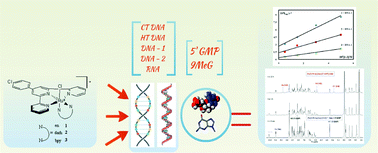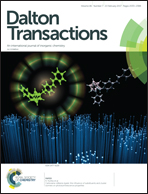Kinetic and mechanistic study on the reactions of ruthenium(ii) chlorophenyl terpyridine complexes with nucleobases, oligonucleotides and DNA†‡
Abstract
In this study, we investigated the ability of Ru(II) polypyridyl complexes to act as DNA binders. The substitution reactions of three Ru(II) chlorophenyl terpyridine complexes, i.e. [Ru(Cl-Ph-tpy)(en)Cl]Cl (1), [Ru(Cl-Ph-tpy)(dach)Cl]Cl (2) and [Ru(Cl-Ph-tpy)(bpy)Cl]Cl (3) (Cl-Ph-tpy = 4′-(4-chlorophenyl)-2,2′:6′,2′′-terpyridine, en = 1,2-diaminoethane, dach = 1,2-diaminocyclohexane, bpy = 2,2′-bipyridine), with a mononucleotide guanosine-5′-monophosphate (5′-GMP) and oligonucleotides such as fully complementary 15-mer and 22-mer duplexes with a centrally located GG-binding site for DNA, and fully complementary 13-mer duplexes with a centrally located GG-binding site for RNA were studied quantitatively by UV-Vis spectroscopy. Duplex RNA reacts faster with complexes 1–3 than duplex DNA, while shorter duplex DNA (15mer GG) reacts faster compared with 22mer GG duplex DNA. The measured enthalpies and entropies of activation (ΔH≠ > 0, ΔS≠ < 0) support an associative mechanism for the substitution process. 1H NMR spectroscopy studies performed on complex 3 demonstrated that after the hydrolysis of the Cl ligand, it is capable to interact with guanine derivatives (i.e., 9-methylguanine (9MeG) and 5′-GMP) through N7, forming monofunctional adducts. The molecular structure of the cationic compound [Ru(Cl-Ph-tpy)(bpy)Cl]Cl (3) was determined in the solid state by X-ray crystallography. The interactions of 1–3 with calf thymus (CT) and herring testes (HT) DNA were examined by stopped-flow spectroscopy, in which HT DNA was sensibly more reactive than CT DNA. The reactivity towards the formation of Ru–DNA adducts was also revealed by a gel mobility shift assay, showing that complexes 1 and 2 have a stronger DNA unwinding ability compared to complex 3. Overall, the complexes with bidentate aliphatic diamines proved to be superior to those with bpy in terms of capability to bind to the here studied biomolecules.



 Please wait while we load your content...
Please wait while we load your content...